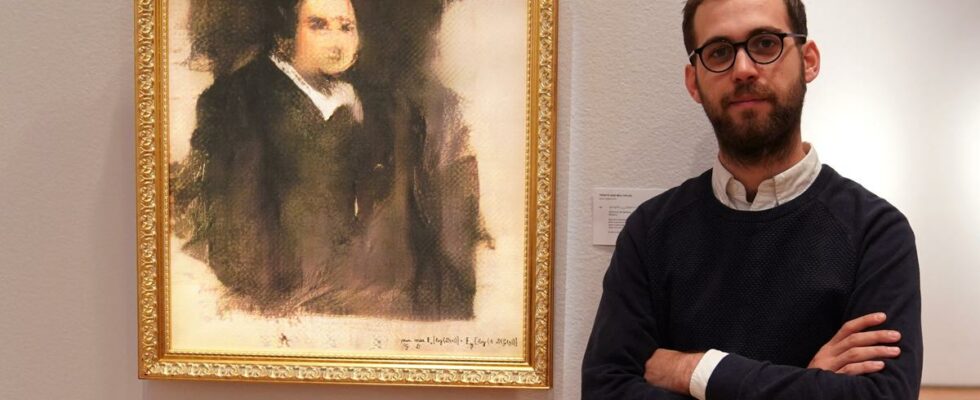In 2018, the trio sold a work presented as the first produced by artificial intelligence software for more than 400,000 euros, at Christie’s, in New York. Timothy A. Clary/AFP
These three 29-year-old childhood friends presented, at the Danysz gallery in Paris, 7.1, their first exhibition, around the Seven Wonders of the World.
Like the painter, his brush, they create works of art with artificial intelligence (AI). In Paris, three 29-year-old childhood friends, united in the collective obviouspioneer of the genre, bet on the flight of this artistic revolution. “The same way a painter uses a knife, a brush, a brush, we use algorithms. Our job is to choose the right one”explains to AFP one of them, Pierre Fautrel, youthful face under a provided beard.
Passionate about art and science, Pierre, Hugo Caselles-Dupré and Gauthier Vernier stunned the art world in 2018 by selling more than 400,000 euros at Christie’s, in New York, a work presented as being the first produced by a artificial intelligence software, Edmond de Belamy, a fictional portrait with blurred outlines, printed on canvas. This first step was taken thanks to the tools developed by other pioneers, shared in “open-source”including code developed by a young British digital art prodigy, Robbie Barrat. “We’ve been working on this for five years, we started at a time when this movement was really in its infancy, and NFT’s (digital objects protected by unforgeable certificates) like AI, which is very rare in the world of art»explains Gauthier Vernier.
Read alsoMathieu Bock-Côté: “Artificial intelligence and falsification of the world”
Seven Wonders of the World
For Hugo Caselles-Dupré, this artistic revolution is comparable to the “democratization” of the photo but it will operate “much faster, in 10 or 20 years”. Building on the progress of AI, which now makes it possible to generate images from texts, the French trio has just presented its first solo exhibition in Paris called 7.1, around the Seven Wonders of the World. This series of seven paintings exhibited in December and January at the Danysz gallery in Paris, is inspired by the mythical Colossus of Rhodes, Hanging Gardens of Babylon, Lighthouse of Alexandria and other Wonders. Conceived from images generated through ancient texts ingested by artificial intelligence, they were then reproduced in oil paint on canvas. Very sharp and vibrant with colors, they recall the imagery of video games, comics or Heroic Fantasy (world of mythological heroes, editor’s note). “We notably used Plato and descriptions of travelers of the time, which are all that remains of the Seven Wonders of the World. We did bibliography work with a historian to create texts that could be injected into an algorithm and create visions., explains Pierre Fautrel. From a simple sentence, the machine is now able to produce representations. “Once the images created on the computer were satisfactory, we chose a style close to oil painting and hired painters to reproduce them”adds Hugo Caselles-Dupré.
Read alsoChatGPT: do you fear the progress of artificial intelligence?
Several paintings were sold for 15,000 euros. For each, a double NFT – digital version “augmented” of the physical work – was created: viewed with a digital tablet, their painted landscapes and subjects come to life, clouds move, flames crackle, waves break. Each NFT was sold in cryptocurrency “5 ethers, or about 7,000 euros”told AFP the gallery owner who exhibited them, Magda Danysz.
Gateways
“We found ourselves on their desire to build bridges between the world of art and tech”adds this enthusiast who has been interested for 30 years in “emerging forms of artistic creation”. The dazzling progress of AI suggests a world where the computer would be able to learn and create, like humans, a frightening potential. Aware of this fear, the trio insists on the philosophy of its approach. “The place of the human is central. What we have always defended is that algorithms are tools, in no way a thinking entity that would replace the artist.he insists.
Read alsoMagda Danysz: “Collage is the 3rd revolution”
Among its many projects, financed by its sales, and in search of partners, the trio is working to create a “research Laboratory” associated with the academic world, somewhat “like the workshops of the Renaissance” which combined technical innovations and art.
